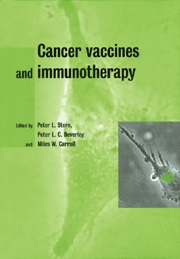Book contents
- Frontmatter
- Contents
- List of contributors
- 1 Immunity and cancer
- 2 Immunotherapy of bladder cancer
- 3 Poxviruses as vectors for cancer immunotherapy
- 4 Vaccinia-based human papillomavirus vaccines in cervical cancer
- 5 Vaccine delivery and immunosuppression in cervical cancer
- 6 Vaccines for colon cancer
- 7 MUC1 vaccines and breast cancer
- 8 Anti-idiotypic vaccination
- 9 Immunotherapy and vaccination against Epstein–Barr virus-associated cancer
- 10 Serologically identified tumour antigens as cancer vaccines
- 11 CTL-defined cancer vaccines in melanoma and other epithelial cancers
- 12 DNA vaccines against B-cell tumours
- 13 Dendritic cell approaches to immunotherapy
- 14 Overview
- 15 Recent developments
- Index
15 - Recent developments
Published online by Cambridge University Press: 06 January 2010
- Frontmatter
- Contents
- List of contributors
- 1 Immunity and cancer
- 2 Immunotherapy of bladder cancer
- 3 Poxviruses as vectors for cancer immunotherapy
- 4 Vaccinia-based human papillomavirus vaccines in cervical cancer
- 5 Vaccine delivery and immunosuppression in cervical cancer
- 6 Vaccines for colon cancer
- 7 MUC1 vaccines and breast cancer
- 8 Anti-idiotypic vaccination
- 9 Immunotherapy and vaccination against Epstein–Barr virus-associated cancer
- 10 Serologically identified tumour antigens as cancer vaccines
- 11 CTL-defined cancer vaccines in melanoma and other epithelial cancers
- 12 DNA vaccines against B-cell tumours
- 13 Dendritic cell approaches to immunotherapy
- 14 Overview
- 15 Recent developments
- Index
Summary
This final chapter aims to update the reader with recent developments in the field of cancer vaccines.
Dendritic cells (DCs) and the control of T-cell activation
A key area of basic research likely to influence the development of cancer vaccines is the increasing understanding of the processes whereby T cells are activated or anergized by interaction with DCs.
An important new concept is of early events which cause immature DCs to sense and relay information about the nature of the danger which subsequently influences the character of the responses. The first step in the activation process for DCs derives from the local microenvironment (pathogen-induced or-derived, or constitutively produced tissue factors) when encountering a specific damage or danger. Following DC maturation and differentiation with presentation of processed antigen and acquisition of co-stimulatory potential, there is a polarization of the T-helper type of response selected in the draining lymph node (LN). Thus, control of the development of naíve T-helper cells into T-helper type 1 (CTL, NK etc.) or type 2 (B-cell activation, isotype switching, etc.) subsets is biased by the first experiences of the DC. Therefore, specific T cells are presented not only with the antigen structure but also the nature of the pathogenicity (danger). Since the window of sampling for such DC-mediated polarization is short it may not necessarily be the same in every LN, allowing for independent regulation.
- Type
- Chapter
- Information
- Cancer Vaccines and Immunotherapy , pp. 268 - 278Publisher: Cambridge University PressPrint publication year: 2000



